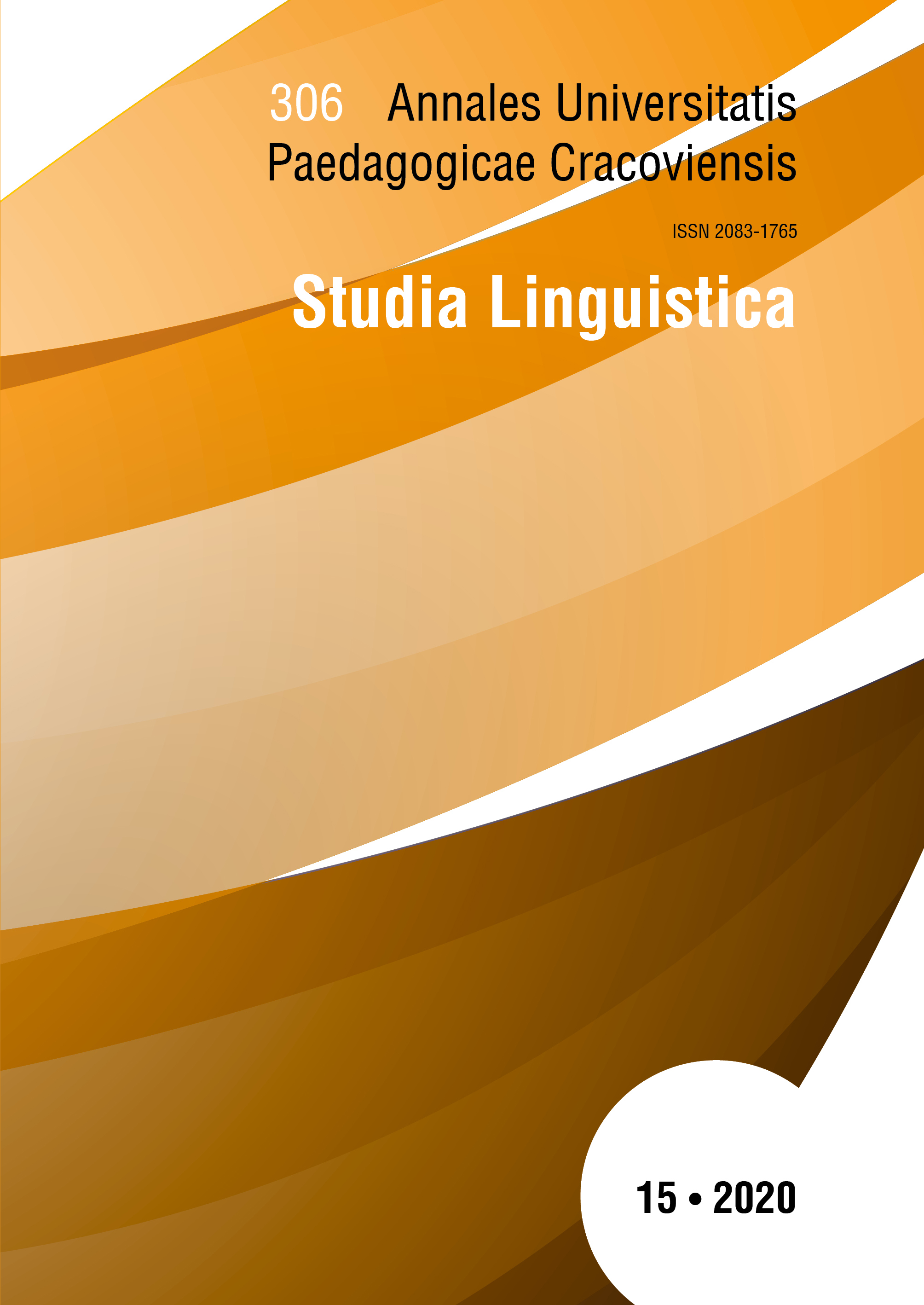Jabłko Adama vel grdyka – konteksty leksykograficzne, kulturowe, medyczne
Main Article Content
Abstrakt
Assuming the perspective of a multi-aspect overview, in this paper a linguistic-cultural-terminological analysis of thyroid cartilage (Latin cartilago thyroidea) has been made, with special consideration given to its fragment known as laryngeal prominence, throat, apple of man or, most commonly, Adam’s apple.
In the linguistic-anthropological part of the study, lexicographic and cultural contexts are considered, in which the word combination from the title is fixed. In turn, the medical description of Adam’s apple includes anatomical and physiological aspects, as well as relevant terminology.
Downloads
Article Details

Utwór dostępny jest na licencji Creative Commons Uznanie autorstwa – Użycie niekomercyjne – Bez utworów zależnych 4.0 Międzynarodowe.
Autor, zgłaszając tekst do redakcji czasopisma „Annales Universitatis Paedagogicae Cracoviensis. Studia Linguistica”, zaświadcza, iż jest on rezultatem wyłącznie jego własnej twórczości, że treść artykułu nie była dotychczas publikowana oraz że utwór nie narusza w żadnym stopniu praw autorskich ani praw pokrewnych innych osób, jak również innych praw osób trzecich, a także, że niczyje prawa do utworu (lub jego jakiejkolwiek części) nie zostały pominięte. Po podpisaniu umowy prawa majątkowe do opublikowanych materiałów zostają przeniesione na Wydawnictwo Naukowe Uniwersytetu Komisji Edukacji Narodowej w Krakowie.
Rocznik „Annales Universitatis Paedagogicae Cracoviensis. Studia Linguistica” to czasopismo o otwartym dostępie, a cała jego zawartość jest udostępniana bezpłatnie dla użytkowników i instytucji na zasadach licencji Creative Commons CC-BY-NC-ND 4.0 (uznanie autorstwa, użycie niekomercyjne, bez utworów zależnych). Na podstawie tej licencji autorzy zgadzają się, że ich prace mogą być zgodnie z prawem ponownie wykorzystywane do jakichkolwiek celów, za wyjątkiem celów komercyjnych, bez konieczności uzyskania uprzedniej zgody ze strony autora lub wydawcy. Każdy może prace te czytać, pobierać, kopiować, drukować, rozpowszechniać oraz przetwarzać, pod warunkiem poprawnego oznaczenia autorstwa oraz oryginalnego miejsca publikacji. Publikowanych tekstów nie można wykorzystywać do tworzenia utworów zależnych (np. do tłumaczenia ich i publikowania w innym języku bez zgody wydawcy). Jest to zgodne z definicją otwartego dostępu BOAI (Budapest Open Access Initiative) „Studia Linguistica”nie pobiera opłat za składanie artykułów ani ich przetwarzanie.
Autor, przesyłając artykuł do redakcji „Studia Linguistica”, bezwględnie zgadza się z poniższymi punktami:
-
Oświadczam, że jestem Autorem lub Współautorem nadesłanego tekstu. Przesłany tekst nie był nigdzie publikowany, jest całkowicie oryginalny i nie narusza w żadnym stopniu praw autorskich ani praw pokrewnych innych osób, jak również innych praw osób trzecich, a także, że niczyje prawa do utworu nie zostały pominięte.
-
Oświadczam, że nadesłany tekst nie został złożony do recenzji lub/i publikacji w innym czasopiśmie.
-
Przyjmuję do wiadomości, że Autor ponosi pełną odpowiedzialność za każdy przypadek plagiatu, niezależnie od tego, czy został on wykryty podczas procesu recenzji, czy po publikacji w „Studia Linguistica”.
-
Oświadczam, że ponoszę pełną odpowiedzialność finansową i prawną za wszelkie roszczenia związane z utworem.
-
Potwierdzam uznanie wszystkich źródeł danych wykorzystanych i cytowanych w badaniach.
-
Potwierdzam, że artykuł został wykonany z należytą starannością zgodnie ze standardami edytorskimi „Studia Linguistica”.
Bibliografia
Biedermann H., 2001, Leksykon symboli, Warszawa.
Google Scholar
Boryś W., 2010, Słownik etymologiczny języka polskiego, Kraków.
Google Scholar
Chenel A.P., Simarro A.S., 2008, Słownik symboli, przeł. M. Boberska, Warszawa.
Google Scholar
Cirlot J.E., 2006, Słownik symboli, Kraków.
Google Scholar
Hamerlińska-Latecka A., 2015, Onkologopedia. Logopedia wobec chorób nowotworowych, Bydgoszcz.
Google Scholar
Iwankiewicz S., 1984, Otolaryngologia. Podręcznik dla studentów medycyny i stomatologii, Warszawa.
Google Scholar
Kalniuk T., 2018, Folklorystyczne opisy początków świata i człowieka, „Annales Missiologici Posnaniensis” III, s. 111–120.
Google Scholar
Koneczna H., 1933, Jabłko Adama, „Poradnik Językowy”, z. 9/10, s. 166–167.
Google Scholar
Kopaliński W., 1985, Słownik mitów i tradycji kultury, Warszawa.
Google Scholar
Kopaliński W., 1990, Słownik symboli, Warszawa.
Google Scholar
Kowalski J., 2011, Homo eroticus, Opole.
Google Scholar
Kozołub A., 2003, Anatomia i fizjologia narządów mowy, głosu i słuchu, [w:] Logopedia. Pytania i odpowiedzi. Podręcznik akademicki, t. 1: Interdyscyplinarne podstawy logopedii, red. T. Gałkowski, G. Jastrzębowska, Opole, s. 127–143.
Google Scholar
Kuczkowski J., 2014, Anatomia i fizjologia obwodowego i ośrodkowego narządu mowy. Patologia narządu mowy, [w:] Biomedyczne podstawy logopedii, red. S Milewski, J. Kuczkowski, K. Kaczorowska-Bray, Gdańsk, s. 104–140.
Google Scholar
Kuczkowski J., 2016, Anatomiczno-fizjologiczne podstawy głosu, [w:] Logopedia artystyczna, red. B. Kamińska, S. Milewski, Gdańsk, s. 258–275.
Google Scholar
Lurker M., 1994, Przesłanie symboli w mitach, kulturach i religiach, przeł. R. Wojnakowski, Kraków.
Google Scholar
Maniecka-Aleksandrowicz B., 1997, Klasyfikacja zaburzeń głosu, „Audiofonologia” X, s. 61–67.
Google Scholar
Oleśkiewicz A., 2007, Europa języków. Związki frazeologiczne o proweniencji biblijnej i antycznej w europejskiej wspólnocie słownikowej, Kraków.
Google Scholar
Oestererreicher-Moliwo M., 1992, Leksykon symboli, tłum. J. Prokopiuk, Warszawa.
Google Scholar
Pawłowski B. red., 2009, Biologia atrakcyjności człowieka, Warszawa.
Google Scholar
Pruszewicz A. red., 1992, Foniatria kliniczna, Warszawa.
Google Scholar
Puda-Blokesz M., 2015, A złote jabłko stało się jabłkiem niezgody – o kulturowym i leksykograficznym wymiarze dwóch mitologizmów z komponentem nazywającym owoc, „Annales Universitatis Paedagogicae Cracoviensis. Studia Linguistica” X, s. 146–162.
Google Scholar
Składzień J., 2017, Neuropatofizjologia głosu śpiewaka z perspektywy neuronauk i otolaryngologii, [w:] Neuropsychologia, neurologopedia i neurolingwistyka in honorem Maria Pąchalska, red. G. Jastrzębowska, J. Góral-Półrola, A. Kozołub, Opole, s. 169–188.
Google Scholar
Jabłko Adama vel grdyka – konteksty leksykograficzne, kulturowe, medyczne
Google Scholar
Sokołowska-Pituchowa J. red., 2019, Anatomia człowieka. Podręcznik dla studentów medycyny, wyd. VIII, Warszawa.
Google Scholar
Zieliński R., 2007, Wybrane zagadnienia z anatomii przełyku i fizjologii połykania, [w:] Otorynolaryngologia dziecięca, red. D. Gryczyńska, Bielsko-Biała, s. 355–357.
Google Scholar
